
Austrocidaria parora is a species of moth of the family Geometridae. It is endemic to New Zealand.
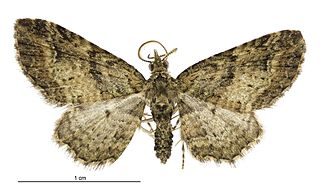
Pasiphila charybdis is a species of moth in the family Geometridae. It is endemic to New Zealand.
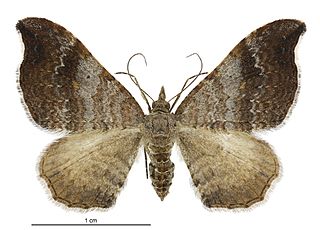
Homodotis megaspilata, also known as the small hooked-tip looper moth, is a moth of the family Geometridae. It is endemic to New Zealand and can be found throughout the country. It is regarded as being common species. The preferred habitat of this species is native forest, scrub, coastal areas and domestic gardens. Larvae feed on the dead leaves of Geniostoma ligustrifolium and likely other native plants. Once mature the larvae will pupate on the ground forming a silken cocoon protected by hiding inside two leaves of its host plant. Adults are nocturnal and are on the wing from October to April. They are attracted to light. In appearance the adults of this species are extremely variable but can be distinguished from similar species as all variations have forewings with blunt hook shaped tips.

Asaphodes beata is a species of moth in the family Geometridae. It is endemic to New Zealand and is a relatively common species that can be found throughout the country in native forest or scrub habitat. It can be distinguished from its close relative Asaphodes adonis by the colour of its hind wings. The larvae of this species feeds on watercress but tends to be inactive during the day. If threatened it will mimic a twig dropping to the ground. The adult moths are on the wing from October to March and are said to be attracted to white rātā. The white markings on the forewing of the adults are variable in appearance.
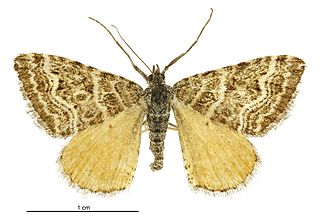
Xanthorhoe bulbulata is a species of moth in the family Geometridae. It is endemic to New Zealand. It is classified as critically endangered by the Department of Conservation.

Asaphodes cataphracta is a moth in the family Geometridae. It is endemic to New Zealand and is found in the South Island. This species prefers grassy or tussock covered mountain side slopes as habitat. The adults of this species are on the wing from December until March. The larvae of A. cataphracta is known to consume native mountain buttercups (Ranunculaceae).

Asaphodes chionogramma is a moth in the family Geometridae. It is endemic to New Zealand and found in both the North and South Islands. This species inhabits the lower slopes of mountains in valleys with native forest at altitudes of between 2000 and 3000 ft. The adults of this species are on the wing in December and January.

Asaphodes chlamydota is a moth in the family Geometridae. It is endemic to New Zealand, and can be found in the lower part of the North Island and in the South Island. It inhabits native forest and shrublands. The larvae of this species feeds on native Clematis plants including Clematis afoliata. Adults are on the wing from November to April and are regarded as having intermedia flight powers.
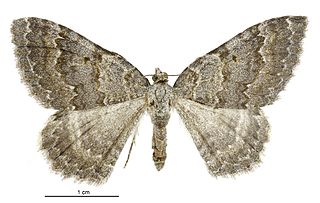
Gingidiobora subobscurata is a species of moth in the family Crambidae. It is endemic to New Zealand. This species has been classified as "At Risk, Declining" by the Department of Conservation.
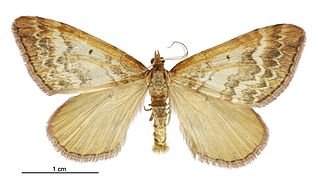
Asaphodes helias is a species of moth in the family Geometridae. It is endemic to New Zealand. It has been found in the middle and southern parts of the South Island. This species frequents tussock and scrubby habitat. The host plants of the larvae of this species include Cardamine and Ranunculus species. They have also been witnessed feeing on exotic buttercup species in the genus Bellis. Adults are on the wing in January and February.
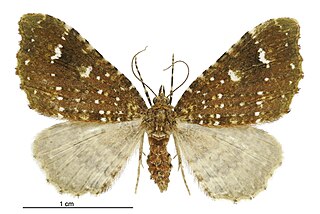
Asaphodes limonodes is a species of moth in the family Geometridae. It is endemic to New Zealand and is found in both the North and South Islands. This species inhabits damp native forest. Adults are on the wing from November until March.

Orthoclydon chlorias is a species of moth in the family Geometridae. It is endemic to New Zealand.

Tingena apanthes is a species of moth in the family Oecophoridae. It is endemic to New Zealand and found in the North Island. The adults are on the wing from October to December. It appears associated with Leptospermum species and it has been hypothesised that the appearance of the adults of this species imitates faded Leptospermum leaves.

Tingena chloritis is a species of moth in the family Oecophoridae. It is endemic to New Zealand and has been found in the South Island. Larvae of this species feed on leaf litter. The adults of this species are light flyers and are attracted to light.
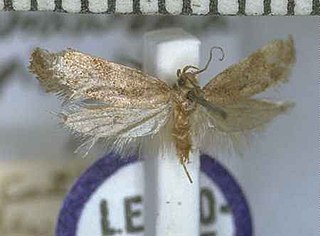
Tingena epimylia is a species of moth in the family Oecophoridae. It is endemic to New Zealand and is found in both the North and the South Islands. This species is similar in appearance to Tingena contextella as it too has a mottled appearance, but T. epimylia can be distinguished as it is smaller in size, slightly narrower wings, and has a more grey appearance and a grey head. This species inhabits native beech forests at altitudes between 1500 and 2000 ft and in particular has an affinity for Nothofagus solandri.

Tingena horaea is a species of moth in the family Oecophoridae. It is endemic to New Zealand and have been observed in both the North and South Islands. The adults are on the wing in January.

Asaphodes nephelias is a moth in the family Geometridae. It is endemic to New Zealand and has been observed in the South Island. The preferred habitat of this species is alpine tussock grasslands above native forest and in wetlands. The adults of this species are on the wing from January to March and are day flying. The female has brachypterous wings.

Asaphodes omichlias is a moth in the family Geometridae. It is endemic to New Zealand and has been observed in both the North and South Islands. This species inhabits rocky, open country in high mountains. Adults are on the wing in January and February. The appearance of the adult of this species is variable with some specimens having a paler and more grey appearance than the more usual brown appearance.

Asaphodes prasinias is a moth in the family Geometridae. It is endemic to New Zealand and has been found on both the North and South Islands. This species inhabits native forest including beech forest and subalpine scrub. The range of this species has reduced as this species is regarded as being locally extinct in the previously inhabited open non-forest habitats around Invercargill. Adults are on the wing from November to January.

Xanthorhoe orophylloides is a moth of the family Geometridae. It was first described by George Hudson in 1909 and is endemic to New Zealand. This species is found in the subantarctic islands including at the Auckland Islands and at Campbell Island.





















